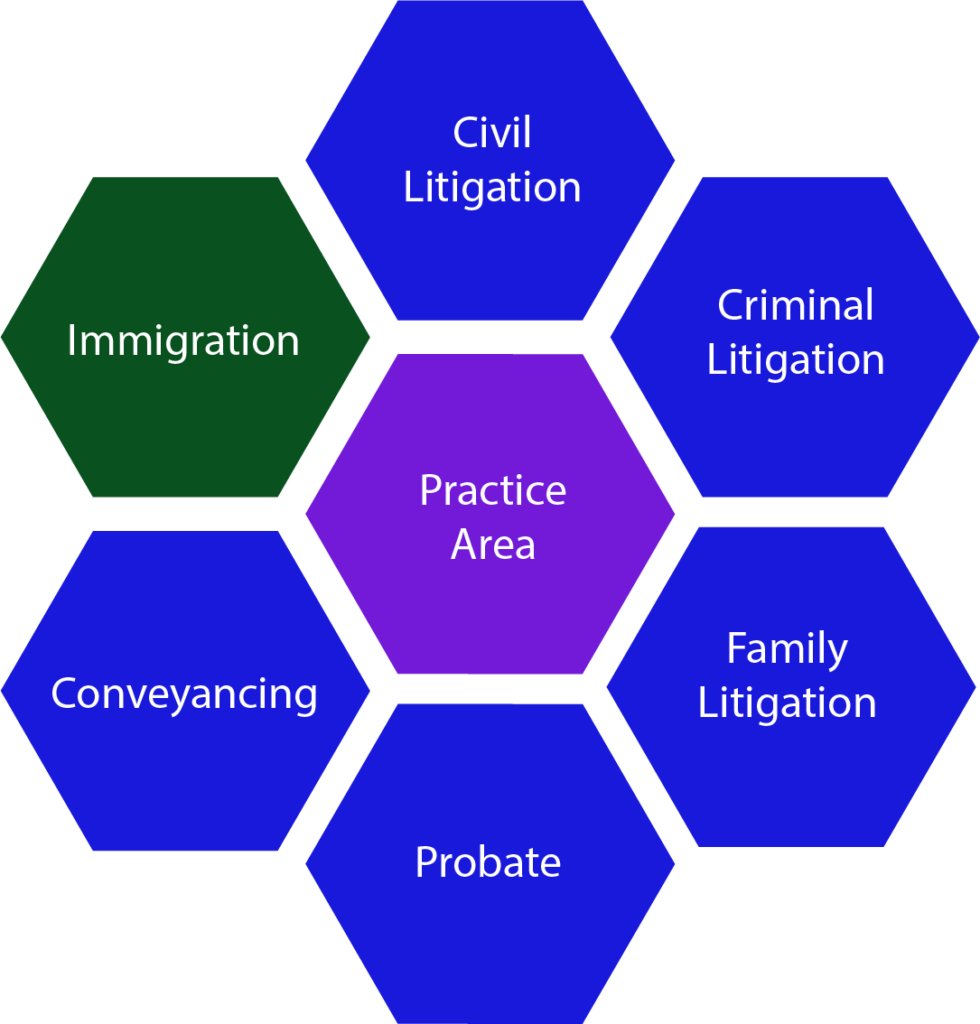
Becoming a CILEx Practitioner (gaining Practice Rights), means that you can practise in areas of practice that are restricted. This is the first step towards owning your own authorised law firm.
There are a number of options as shown in the diagram on the right.
The practice areas in blue are reserved activities under the Legal Services Act. Immigration, although not reserved to people authorised through the Act, is a regulated activity and therefore we need to authorise you to undertake this work, if you aren’t otherwise supervised. If you are unsure, please check with us before undertaking immigration work.
Find out more about our ULAW route to Practice Rights.
Practice Rights Certificate for Chartered Legal Executive Rules
Civil Litigation Rights
Becoming authorised as a CILEx Practitioner in civil litigation enables you to undertake both civil litigation and advocacy in the lower courts. However, if you want to practise as self-employed in civil litigation, you will also need to work within an authorised law firm. Find out more about setting up your own firm with CILEx Regulation.
Criminal Litigation Rights
Becoming authorised as a CILEx Practitioner in criminal litigation enables you to undertake both criminal litigation and advocacy in the magistrates’ courts. However, if you want to practise as self-employed in criminal litigation, you will also need to work within an authorised law firm. Find out more about setting up your own firm with CILEx Regulation.
Family Litigation Rights
Becoming authorised as a CILEx Practitioner in family litigation enables you to undertake both family litigation and advocacy in the Family Court. However, if you want to practise as self-employed in family litigation, you will also need to work within an authorised law firm. Find out more about setting up your own firm with CILEx Regulation.
Probate Rights
Becoming authorised as a CILEx Practitioner in probate practice enables you to undertake probate work as well as estate administration and will-writing. However, if you want to practise as self-employed in probate practice, you will also need to work within an authorised law firm. More information on setting up your own firm with CILEx Regulation can be found here.
Conveyancing Rights
Becoming authorised as a CILEx Practitioner in conveyancing practice enables you to undertake conveyancing work. However, if you want to practise as self-employed in conveyancing practice, you will also need to work within an authorised law firm. Find out more about setting up your own firm with CILEx Regulation.
I would recommend other CILEx members to apply for Practice Rights without hesitation! It allows members to have something to show for their years of hard work. It’s a fantastic feeling when you receive your practising certificate for the first time; it puts us on an equal footing with other legal practitioners as we should be! It is a very proud moment indeed.
Sian Turvey, Chartered Legal Executive & CILEx Conveyancing Practitioner at Robertsons Solicitors
Immigration Rights
Becoming authorised as a CILEx Practitioner in immigration practice enables you to undertake immigration work, but excluding appointing a representative and advocacy in the Upper Tribunal for judicial review. However, if you want to practise as self-employed in immigration practice, you will also need to work within an authorised law firm. More information on setting up your own firm with CILEx Regulation can be found here.
Making an application for practice rights
Whichever practice right you are looking to apply for, the process follows the same basic steps:

| Academic stage | Demonstrate Level 6 knowledge in relevant area of law and practice |
| Experience | Demonstrate five years of legal experience, including at least two years in your chosen specialism |
| Demonstrate competence | Complete the Skills Log. For Litigation rights, you will also need to complete the Advocacy course |
| Satisfy character and suitability requirements | |
| Admission | |
| Post-authorisation (for advocacy rights) | After one year those with advocacy rights have to undergo a renewal process to demonstrate how they have used their advocacy rights. |
Throughout the application process, any help I needed from CILEx Regulation was obtained easily, either by phone or email. It was clear throughout the whole process that CILEx Regulation was keen to encourage and assist with my application…
Michael Fletcher, CILEx Litigator (Civil) & Chartered Legal Executive Advocate Glaisyers Solicitors
Additional resources
- ULAW route to Practice Rights
- Independent Practice Rights now – Regulation Matters feature
- Gaining Practising Rights – webinar recording
- Practitioner Application guidance
Portfolio Route – annexes to application form
Annex 1 Knowledge and Understanding portfolio route Template
Annex 2 Experience portfolio route Template
Annex 3 Logbook Sheet portfolio route Template
Annex 4 Advocacy Experience portfolio route Template
Annex 5 Advocacy portfolio route Template
Annex 6 Police Station Advice portfolio route Template
Skills Logbook examples (by area)
Civil Litigation
Civil Litigation skills logbook
Civil Litigation Portfolio example
Civil Advocacy Portfolio example
Conveyancing
Client Care
Legal Research
Interviewing, Advising & Communicating
Costs & Funding
Professional conduct & Ethics
Managing conveyancing work
Legal writing and drafting
Negotiation
Conveyancing Portfolio example
Family
Family Advocacy Portfolio Example
Family Litigation Example
Family Skills Logbooks
Probate
Probate skills logbook
Probate Portfolio example
Criminal
Criminal Experience Portfolio
Criminal Advocacy Portfolio
Criminal Skills Logbooks:
Elements 1-2
Element 3
Elements 3-4
Element 4
Element 5


